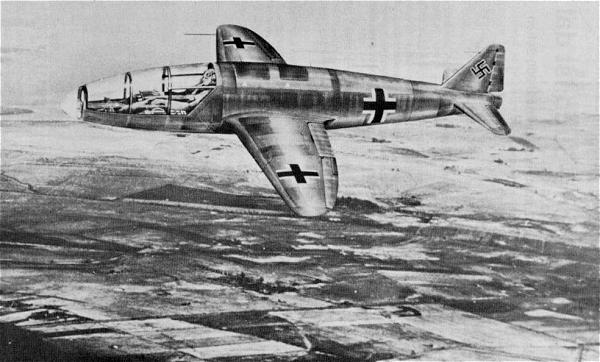and another 19 flights between June 12 and November 8, 1939.
| Span | Length | Height | Wing Area |
| 5.0 m 16' 5" |
6.2 m 20' 4" |
1.44 m 4' 9" |
5.5 m² 59.2 ft² |
| Empty | Fuel | Payload | Max. Takeoff |
| 900 kg 1984 lbs |
430 kg 948 lbs |
720 kg 1587 lbs |
1620 kg 3572 lbs |
| Max. Speed | Cruise Speed | Ceiling | Max. Range | Landing Speed |
|
466 mph @ 13123' |
441 mph |
9000 m 29527' |
110 km 68 miles |
135 km/h 84 mph |
| Manufacturer | Scale | Material | Notes |
| RS | 1/72 | resin | models correct version |
| 12 Squared |
1/72 |
injected | models incorrect second version |
| Classic Plane |
1/72 | vacuform |
models incorrect second version |
Click Here for a large format 6-view drawing of the Heinkel He 176

This is the only known photograph of the actual Heinkel He 176 prototype aircraft, probably taken at Peenemünde in 1938.

For many years, this was how the Heinkel He 176 was thought to look. Image by Gert Heumann.

Above: A Heinkel He 112 fitted with a von Braun liquid oxygen/alcohol rocket engine. It flew in April 1937 using both its propeller and also rocket power. Right: Testing the von Braun rocket engine in the fuselage of a Heinkel He 112. |

|

This is a photo of the Heinkel He 112 V3
(coded D-IDMO) while it was being made ready for another test run.
Three He 112s were donated for rocket tests with the von Braun engine. Two were destroyed during testing, and the final aircraft made several flights using both propeller and rocker power.

A Focke-Wulf Fw 56 undergoing tests with the Walter rocket engine, which was later fitted in the He 176.
This photo was taken at Neuhardenberg and in the background can be seen one of the three He 112s also used in rocket propulsion tests.
Flugkapitän Erich Warsitz (white coveralls) is congratulated
by Erhard Milch after the successful
demonstration of the Heinkel He 176 on June 21, 1939. Professor Ernst Heinkel is to the right.


This photo was taken after the successful first official flight of the Heinkel He 176 in July 1939
at Peenemünde. Ernst Heinkel faces the camera, while test pilot Erich Warsitz sits.
demonstration of the Heinkel He 176 on June 21, 1939. Professor Ernst Heinkel is to the right.


This photo was taken after the successful first official flight of the Heinkel He 176 in July 1939
at Peenemünde. Ernst Heinkel faces the camera, while test pilot Erich Warsitz sits.
 The story of the Heinkel He 176 rocket powered
aircraft has been clouded in mystery and incorrect information for many
years. Only in the last few years have some of the real facts emerged.
The story of the Heinkel He 176 rocket powered
aircraft has been clouded in mystery and incorrect information for many
years. Only in the last few years have some of the real facts emerged.